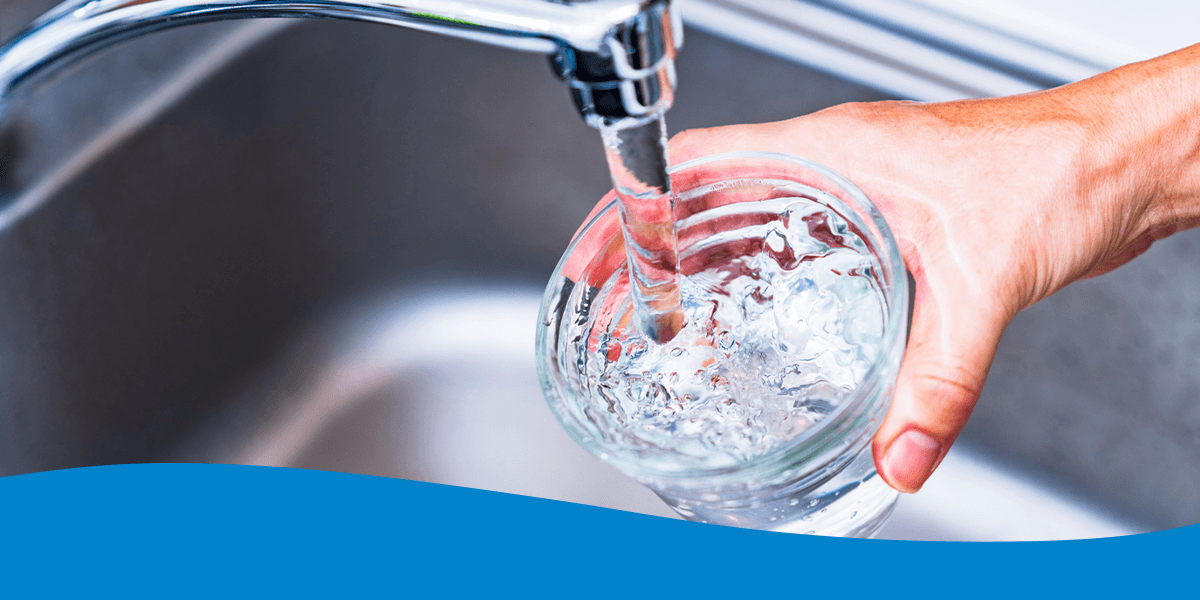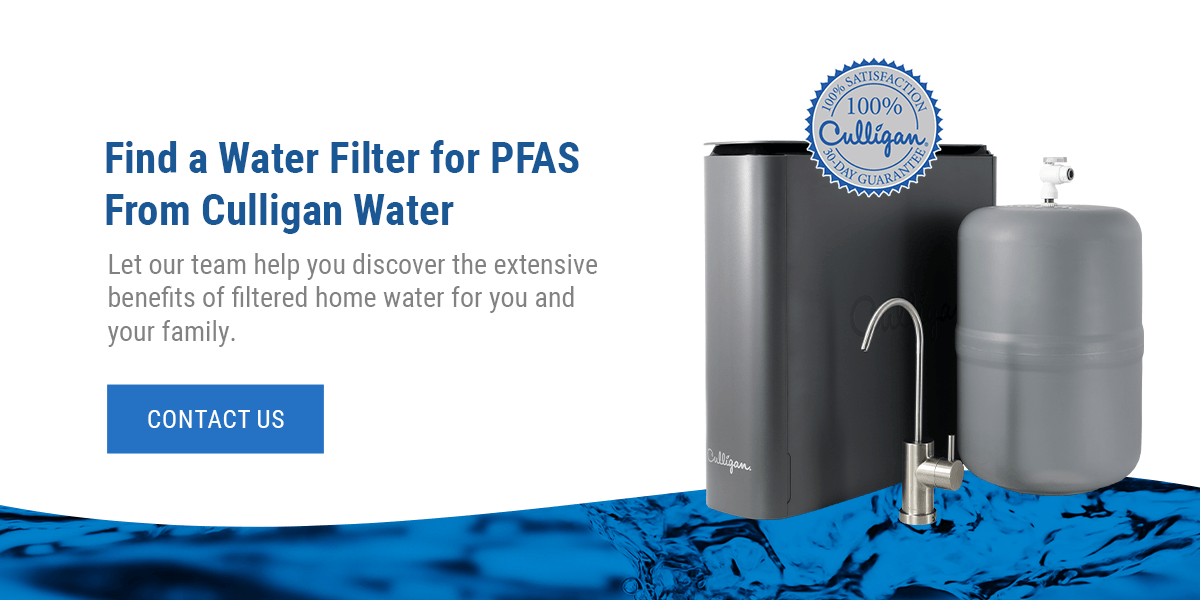Table of Contents

Understanding PFAS Chemicals
Estimates suggest that around 40% of tap water in the United States contains per- and polyfluorinated alkyl substances (PFAS). With growing concerns over these forever chemicals, many people are wondering how to reduce their exposure and what regulatory bodies are doing to address them. Below, you can learn more about PFAS, including their potential impact on your health and how to filter them out of your drinking water.
What Are PFAS, and What Is Their Impact?
PFAS are long-lasting synthetic chemicals found in many common items. Due to their water and heat resistance and ability to repeal oil, they’ve been present in industry and consumer products for decades. While PFAS have been useful for products like waterproof clothing, food packaging, stain-resistant furniture and nonstick cookware, their negative impacts are becoming clearer.
The widespread occurrence, growing numbers and unknown persistence of PFAS are causing concern. The U.S. Environmental Protection Agency (EPA) has recognized more than 15,000 synthetic chemicals that remain in the environment for undetermined periods of time. Additionally, people can encounter PFAS in several ways, providing opportunities for more chemicals to enter the body before previous chemicals can leave.
A Deeper Look at PFAS Exposure
Drinking water is a significant concern regarding PFAS exposure. Research shows that more than 200 million Americans are exposed to water containing PFAS. Beyond water, there are other significant exposure risks for Americans.
These chemicals also exist in fabric treatments to create stain-resistant carpets and furniture. Water-repellent clothing and even some cosmetics and personal care products use PFAS to create products with the appearance of convenience.
How PFAS Affect Our Health
There’s still a lot we don’t know about PFAS. The growing number of chemicals and their long-lasting persistence call for constant monitoring. However, there are some health effects federal agencies have documented based on what we do know about these substances. Currently, documented health effects from exposure to certain PFAS levels include:
- Reproductive effects like increased blood pressure in pregnant women or decreased fertility.
- Delays or development effects in children, such as bone variations, low birth weight, behavioral changes or accelerated puberty.
- Increased risk of testicular, kidney and prostate cancers.
- Natural hormone interference.
- Increased risk of obesity or higher cholesterol levels.
- Reduced ability to fight infections and reduced vaccine response.

What’s the Difference Between PFAS in Water and Microplastics in Water?
PFAS and microplastics often appear together in conversations about environmental pollutants. Both can appear in drinking sources and pose risks for people, but they have fundamental differences.
Microplastics are small plastic pieces that come from various sources, such as synthetic clothing fibers, broken-down plastic items and similar items. While more research is necessary to understand the long-lasting implications of microplastics, some studies have suggested adverse health effects like organ dysfunction, neurotoxicity, DNA damage, oxidative stress and metabolic disorder.
One critical aspect to note is that microplastics can interact with other organisms and chemicals, including PFAS, in water. This combination could worsen risks for humans and animals who consume contaminated water or seafood.
EPA PFAS Drinking Water Standards
The EPA is confronting PFAS in several ways. From developing water quality standards to improving PFAS contamination accountability, the agency is seeking new ways to reduce exposure and help the environment. While some findings serve as a benchmark for creating programs, others are forming new policies.
In April 2024, the EPA announced the finalized National Primary Drinking Water Regulation for six key forever chemicals. The EPA has also finalized some standards for several drinking water PFAS, such as:
- Maximum Contaminant Levels to reduce exposure from drink water PFAS.
- Limit for combining specific types of PFAS.
- Statement that no safe level of PFAS in drinking water exists.
How to Filter Out PFAS From Your Water
While organizations are working to define efforts for reducing drinking water contamination, you can take steps to reduce your exposure to PFAS in daily life. One of the best ways to minimize PFAS consumption is to invest in an at-home water filter. These systems are certified to reduce and remove PFAS in water through filtration. Depending on your needs, you can choose from a variety of systems, such as a pitcher filter, a whole-home system or a faucet filter.
PFAS water filters use different technologies to filter out PFAS and create cleaner drinking water.
Reverse Osmosis Systems
A reverse osmosis system works by pressurizing water and pushing it across a semi-permeable membrane, leaving chemicals behind. The system then flushes those chemicals away, and clean water moves to a holding tank so you can access your filtered supply.
These systems can remove several types of pollutants and contaminants, such as detergents, sediment, nickel, calcium and sulfates. These systems also pair well with other water treatment systems, empowering you to address home-specific issues easily. Additionally, you can find under-the-sink systems to save space while improving your water quality.
Granular Activated Carbon (GAC)
GAC filters are impactful for removing certain chemicals from water but are not suitable for reducing chemicals like nitrate and iron. In many cases, combining GAC filtration with reverse osmosis systems offers a comprehensive solution for home water filtration.
These water filters, also referred to as charcoal filters, use activated carbon to trap and remove dissolved chemicals. It’s important to choose a GAC filter with the proper components and size to address the concentration and type of chemicals you’re facing.
Ion Exchange Resins
An ion exchange resin can remove impurities like minerals that are associated with poor water quality. These filters use electrically charged solids to separate drinking water and contaminants. Additionally, anion exchange filters address negatively charged contaminants, and cation exchange filters address positively charged pollutants. These treatment types are generally more expensive than GAC but can have a high capacity for PFAS.
Find a Water Filter for PFAS From Culligan Water
While forever chemicals require more research before we can truly understand their impact, homeowners can take proactive steps to target PFAS in their drinking water and create safer homes. Working with a water treatment product expert can help you select the right option for your house and needs.
Culligan Water is a local team of water conditioning professionals. With more than 75 years of experience, immense local knowledge and a service-focused mission, Culligan Water is your Mechanicsburg water quality solution provider. Our team proudly offers drinking water systems, whole-home filtration solutions and other water filters and purifiers to improve water quality.
Let our team help you discover the extensive benefits of filtered home water for you and your family. If you’re looking to address PFAS concerns, contact our team to discover the best water filter for PFAS and how our solutions can assist.

